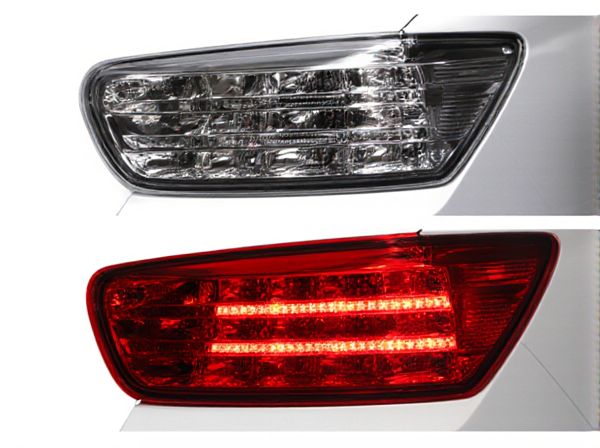
Photo illustration: Halogen vs LED Taillight
LED taillights offer greater energy efficiency and longer lifespan compared to traditional halogen bulbs, reducing maintenance costs. Halogen lights typically emit a warmer glow, while LED lights provide brighter, more precise illumination that enhances visibility and safety. Choosing LED taillights can improve your vehicle's overall lighting performance and modern aesthetic.
Table of Comparison
| Feature | Halogen Taillight | LED Taillight |
|---|---|---|
| Brightness | Moderate, diffused light | High, focused light |
| Energy Efficiency | Low, higher power consumption | High, low power usage |
| Lifespan | 1,000 - 2,000 hours | 25,000+ hours |
| Response Time | Slower, filament heats up | Instant illumination |
| Cost | Lower initial cost | Higher upfront cost |
| Durability | Fragile, sensitive to vibration | Robust, shock-resistant |
| Heat Emission | High heat output | Low heat output |
Introduction to Taillight Technologies
Halogen taillights use tungsten filaments encased in halogen gas to produce bright, warm light, while LED taillights employ semiconductor diodes to emit highly efficient, longer-lasting illumination. LED technology offers faster response times and greater energy efficiency compared to traditional halogen bulbs, enhancing vehicle safety and durability. The shift from halogen to LED taillights represents a significant advancement in automotive lighting technology, with LEDs increasingly becoming the industry standard.
What Are Halogen Taillights?
Halogen taillights utilize tungsten filament bulbs encased in halogen gas, producing a warm, bright light by heating the filament until it glows. They are widely known for their affordability and ease of replacement but offer lower energy efficiency and shorter lifespan compared to LED options. Despite their popularity in traditional vehicles, halogen taillights consume more power and generate more heat, making them less environmentally friendly.
What Are LED Taillights?
LED taillights utilize light-emitting diodes to produce brighter, more energy-efficient illumination compared to traditional halogen bulbs. These taillights offer faster response times, enhancing vehicle safety by improving visibility for drivers behind. Their longer lifespan and lower power consumption make LED taillights a superior choice for modern automotive lighting systems.
Energy Efficiency Comparison
LED taillights consume up to 80% less energy compared to halogen bulbs, making them significantly more energy efficient. Halogen lights generate more heat, resulting in energy loss, whereas LEDs convert most of their power directly into light. This efficiency translates to longer battery life and reduced fuel consumption in vehicles using LED taillights.
Brightness and Visibility
LED taillights offer significantly higher brightness levels, producing more lumens per watt compared to halogen taillights, which enhances visibility during both day and night driving. The intense, focused light output from LEDs improves reaction times by making brake signals clearer and more noticeable to other drivers. Halogen bulbs generally emit a softer, dimmer light that can reduce the distance at which a vehicle is visible, especially in adverse weather conditions.
Lifespan and Durability
LED taillights offer a significantly longer lifespan, typically lasting up to 25,000 to 50,000 hours compared to halogen bulbs, which usually last around 500 to 1,000 hours. The solid-state construction of LED lights enhances durability by resisting shock, vibration, and extreme temperatures, making them more reliable for long-term use. Halogen bulbs, with their fragile filaments, are more prone to damage and burnout, reducing overall durability and increasing maintenance frequency.
Installation and Compatibility
LED taillights offer straightforward installation with plug-and-play designs compatible with most modern vehicles, reducing the need for additional wiring or modifications common in halogen setups. Halogen taillights often require more complex installation due to their traditional bulb sockets and may not fit newer vehicles without adapters. Compatibility of LED taillights extends to improved durability and integration with vehicle electronics such as CAN bus systems, unlike halogen lights that may cause warning errors without resistors or adapters.
Cost Analysis: Halogen vs LED
LED taillights have a higher upfront cost compared to halogen bulbs, with prices typically ranging from $50 to $200 for LED kits versus $10 to $30 for halogen replacements. However, LED taillights offer greater energy efficiency and longer lifespan, reducing replacement frequency and maintenance expenses over time. Considering total cost of ownership, LED taillights provide better long-term value despite their initial investment.
Aesthetic and Design Flexibility
LED taillights offer superior aesthetic appeal with sharper illumination and customizable light patterns, enhancing vehicle design. Unlike halogen bulbs, LEDs are compact and lightweight, allowing for innovative shapes and seamless integration into modern automotive styling. Their flexibility in color temperature and brightness enables designers to create distinctive, eye-catching rear lighting that complements both luxury and sporty vehicles.
Which Is Better: Halogen or LED Taillights?
LED taillights outperform halogen bulbs in brightness, energy efficiency, and longevity, consuming up to 80% less power while providing sharper visibility and faster response times. Halogen taillights generate more heat, have shorter lifespans averaging around 1,000 hours, and offer less consistent illumination compared to LEDs, which can last up to 25,000 hours. For enhanced safety, durability, and reduced energy consumption, LED taillights are the superior choice over traditional halogen options.
 caratoz.com
caratoz.com